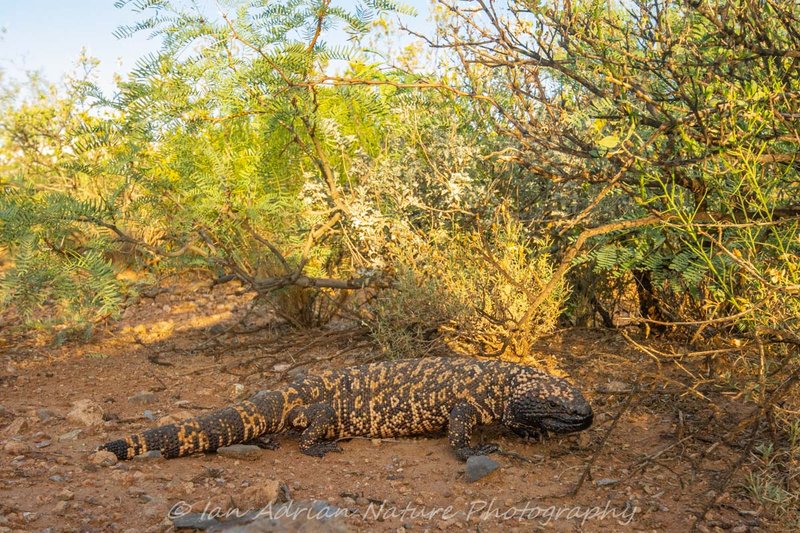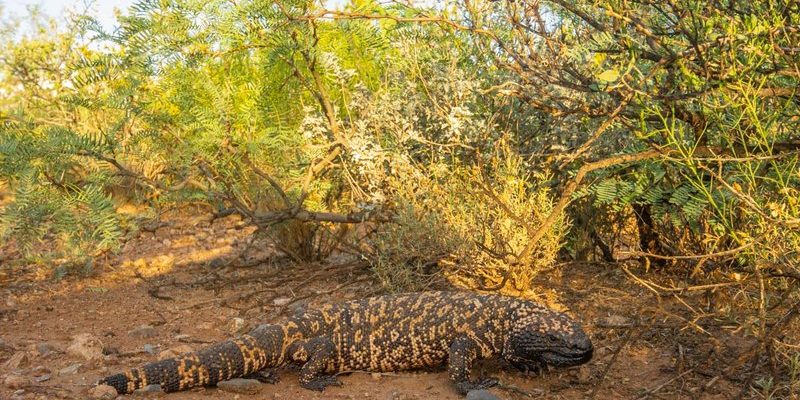
So, why should we care about the role of the Gila monster? Well, much like any other species, it contributes to a delicate balance. It’s a predator, a scavenger, and yes, even a bit of a healthcare provider for the environment. As I share more about this fascinating creature, consider how its interactions sustain the ecosystem. Let’s dive in and explore what makes the Gila monster so special.
What Does a Gila Monster Look Like?
Imagine a creature that’s both striking and a bit intimidating. The Gila monster is easily recognizable thanks to its robust body, short legs, and those bold, bright colors—often a mix of orange or yellow patterns against a black background. These vivid hues aren’t just for show. They serve as a warning to predators that this lizard is not one to mess with.
In fact, the Gila monster is one of only a few venomous lizards in the world. Its venom, which it delivers through grooves in its teeth, is used mainly for hunting and defense. This adaptation gives it a unique advantage in its harsh environment. With its slow-moving nature, the Gila monster relies on its venom to subdue prey, which usually consists of smaller animals like rodents and birds.
Here’s a fun fact: Gila monsters can weigh up to 5 pounds and measure around 2 feet long. They are heavier than many other lizards, which adds to their *distinctive appearance* in the wild.
Where Do Gila Monsters Live?
Gila monsters thrive in the arid regions of the southwestern U.S. and northwestern Mexico. They are particularly fond of areas with rocky terrains, deserts, and scrublands. Their habitat can include everything from dry desert floors to rocky canyons. You might be wondering how a creature like the Gila monster manages to survive in such a tough environment.
These lizards are well adapted to life in the desert. Mostly active during the cooler parts of the day or even at night, they avoid the extreme heat. They spend a lot of time burrowing into the ground or hiding under rocks to escape the sun. With their excellent sense of smell, they can detect food and mates from a distance, which helps them navigate their home terrain.
Interestingly, Gila monsters can also go weeks without food, thanks to their ability to store fat in their bodies. This adaptation is crucial in a place where food sources can be scarce at times.
The Gila Monster’s Diet and Hunting Behavior
Now, let’s talk about what the Gila monster eats. This lizard has a rather interesting diet that sets it apart from many of its reptilian relatives. Primarily, Gila monsters are carnivorous, and they have a taste for small mammals, birds, and *even eggs*.
When hunting, the Gila monster relies on its keen sense of smell to locate prey. Once it finds something suitable, it strikes quickly, using its venom to incapacitate its meal. Here’s the twist: Gila monsters often opt for scavenging. They’re opportunistic eaters and will feast on carrion—dead animals that they stumble upon. This behavior plays a significant role in cleaning up the environment, helping to control the spread of disease.
Also, Gila monsters are known to consume cactus fruit and flowers, adding a plant-based component to their diet. This omnivorous aspect helps them adapt to their surroundings and ensures they have a variety of food sources.
The Gila Monster and Its Role in the Ecosystem
The role of the Gila monster goes beyond just being a predator. It’s an essential player in its ecosystem. Think of it as a cog in a larger machine, where every species has a part to play. By controlling the populations of small mammals and birds, Gila monsters help maintain a balance in their food chain.
Additionally, when they scavenge, they assist in the nutrient cycle of the desert. As they consume carrion, they help break down organic matter, enriching the soil. This, in turn, supports the desert flora that provides oxygen and shelter for various other species.
Lastly, the Gila monster serves as a prey species for larger predators, such as birds of prey and coyotes. Their presence in the food web is vital for the survival of these larger animals, showcasing the interconnectedness of life in the desert.
Conservation Status and Threats
Despite their resilience, Gila monsters face threats from habitat destruction and climate change. Urban development and agricultural expansion are encroaching on their natural habitats, leading to a decline in their populations. This is concerning because, as we’ve discussed, every species plays a role in maintaining ecological balance.
Gila monsters also suffer from illegal collection for the pet trade. Their unique appearances make them desirable, but removing them from their habitats has dire consequences. Conservation efforts are underway to protect this species, but awareness is key.
You might find it interesting to know that Gila monsters are currently listed as “Near Threatened” on the IUCN Red List. This status highlights the importance of continued efforts to monitor and protect their populations.
In summary, the Gila monster is much more than a colorful lizard; it’s a vital part of its ecosystem. From its unique feeding habits to its role in maintaining the balance of life, this creature captivates anyone willing to learn about it. Its adaptations and behaviors reveal how life in the desert is intricately woven together.
So, the next time you think of the desert, remember the Gila monster. It may look tough and intimidating, but it’s a gentle giant in its own right, playing a crucial role in the environment. By protecting them, we help preserve the delicate balance of life that benefits us all.

